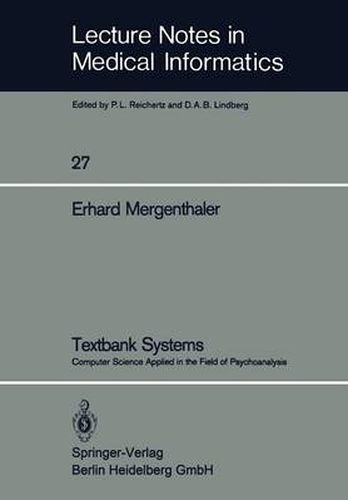Readings Newsletter
Become a Readings Member to make your shopping experience even easier.
Sign in or sign up for free!
You’re not far away from qualifying for FREE standard shipping within Australia
You’ve qualified for FREE standard shipping within Australia
The cart is loading…






This title is printed to order. This book may have been self-published. If so, we cannot guarantee the quality of the content. In the main most books will have gone through the editing process however some may not. We therefore suggest that you be aware of this before ordering this book. If in doubt check either the author or publisher’s details as we are unable to accept any returns unless they are faulty. Please contact us if you have any questions.
Psychoanalysis and information science are two disciplines that twenty years ago hardly anyone would have considered closely related with re gard either to persons or subject matter. The cooperation between the two fields was made possible, on the one hand, by the development of information science from a technological discipline to a theoretically founded scientific discipline, and on the other, by the development of psychoanalysis from a hermetically closed special discipline to an open and empirical science. This study reports the successful inclusion of information science as an instrument of research on the psychoanalytic process. This direction of work was initiated by Donald Spence and Hartvig Dahl from the Re search Institute of Mental Health, New York, at the end of the 1960s. H. Thom~, H. K~che1e, and their research group in Ulm must be credited with having adopted Spence’s programs as early as 1974; at that time the programs even had to be implemented far away on the IBM computer at the University of Heidelberg. The efforts to expand computer-aided con tent analysis to a method for process research led in 1975 to the ac quisition of the Hamburg program for Electronic Verbal Analysis (EVA). In the following years the author of this study revised, extended, and supplemented the EVA to create the U1m version. This book now describes another step in the integration of information technology in fundamen tal research in psychoanalysis.
$9.00 standard shipping within Australia
FREE standard shipping within Australia for orders over $100.00
Express & International shipping calculated at checkout
This title is printed to order. This book may have been self-published. If so, we cannot guarantee the quality of the content. In the main most books will have gone through the editing process however some may not. We therefore suggest that you be aware of this before ordering this book. If in doubt check either the author or publisher’s details as we are unable to accept any returns unless they are faulty. Please contact us if you have any questions.
Psychoanalysis and information science are two disciplines that twenty years ago hardly anyone would have considered closely related with re gard either to persons or subject matter. The cooperation between the two fields was made possible, on the one hand, by the development of information science from a technological discipline to a theoretically founded scientific discipline, and on the other, by the development of psychoanalysis from a hermetically closed special discipline to an open and empirical science. This study reports the successful inclusion of information science as an instrument of research on the psychoanalytic process. This direction of work was initiated by Donald Spence and Hartvig Dahl from the Re search Institute of Mental Health, New York, at the end of the 1960s. H. Thom~, H. K~che1e, and their research group in Ulm must be credited with having adopted Spence’s programs as early as 1974; at that time the programs even had to be implemented far away on the IBM computer at the University of Heidelberg. The efforts to expand computer-aided con tent analysis to a method for process research led in 1975 to the ac quisition of the Hamburg program for Electronic Verbal Analysis (EVA). In the following years the author of this study revised, extended, and supplemented the EVA to create the U1m version. This book now describes another step in the integration of information technology in fundamen tal research in psychoanalysis.